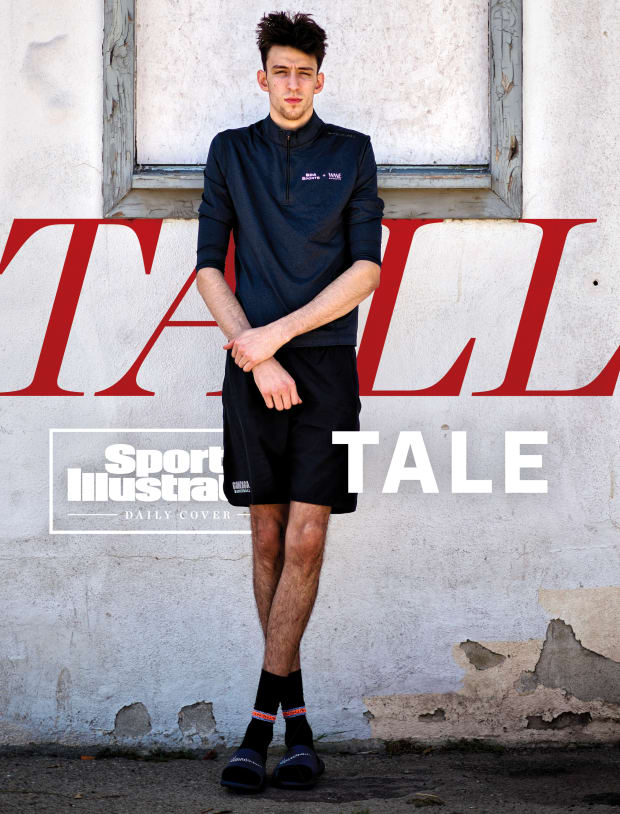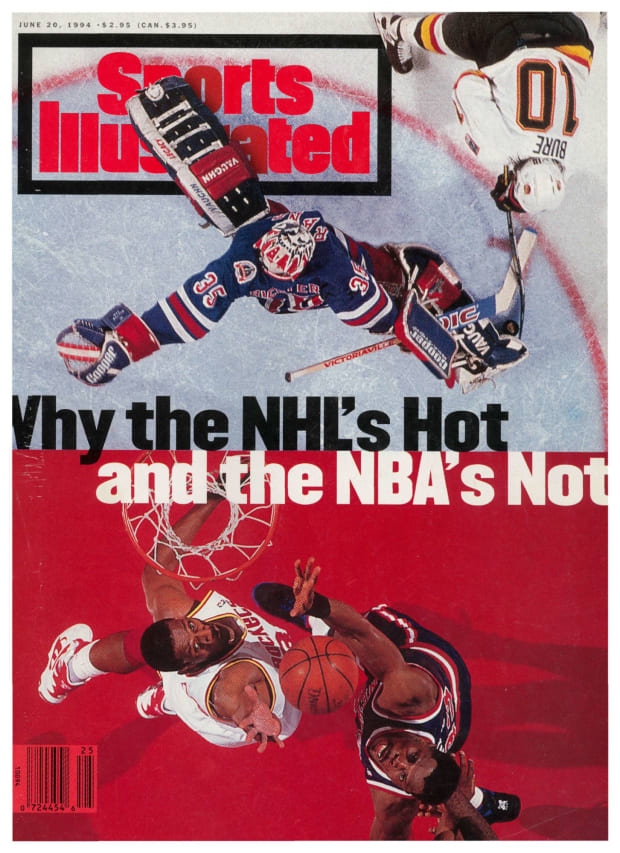Good morning, I’m Josh Rosenblat. We’ll start with a shoutout to my college classmate (for 10 weeks) Matt Fitzpatrick.
In today’s SI:AM:
⚡ The Lightning are in trouble
🔮 The future of basketball is 7’1’’ and 195 pounds
Curry, Warriors Grab a Piece of History
Mention Matt Fitzpatrick before yesterday and one of the next things out of your mouth would have probably been his lack of wins on the PGA Tour. Though he’s won big events around the world and grabbed the prestigious U.S. Amateur title in 2013, the 27-year-old hadn’t yet won an event on the PGA Tour or a professional event in the United States.
Even legend Jack Nicklaus, Fitzpatrick said after his round yesterday, was ribbing him for his lack of trophies. Now Fitzpatrick is in the company of only Nicklaus and Juli Inkster as golfers to win a U.S. Amateur and U.S. Open at the same venue, which the Englishman accomplished at The Country Club outside of Boston yesterday.
Just four weeks ago, Fitzpatrick found himself in the last pairing at the PGA Championship looking for that initial win in America. But his final-round 73 wasn’t near good enough and he finished tied for fifth.
“Some players would never recover,” my colleague Michael Rosenberg wrote. “Fitzpatrick showed up on Sunday of the next major with the lead, hit 17 of 18 greens, and did not leave himself short-sided once all day.”
It seemed like it was a matter of when, not if, Fitzpatrick would get that elusive win. And you could almost sense it coming based on how well he’s played in 2022. Now a top-10 player in the world, Fitzpatrick has played in 13 events this year. Though he missed the cut in three of them, he finished no worse than tied for 18th in the remaining 10, including seven top 10s.
“He loves this,” Rosenberg writes. “That is why he has achieved so much – there are plenty of more naturally talented golfers who will never win a major – and why his victory will be so celebrated among those who understand and care about the game. … Some pro golfers are popular among their peers and some are not, for many reasons, but everybody respects the grind.”
On Fitzpatrick's bag was caddie Billy Foster, who has worked for so long and for so many successful players without winning a major championship. When the birdie attempt from Will Zalatoris—who came oh so close to his first professional win yet again—went by the 72nd hole, Foster couldn’t contain the tears. The 59-year-old has worked for Seve Ballesteros, Thomas Bjorn, Darren Clarke and Lee Westwood, leading him to have “walked nearly every inch of hallowed ground the game has to offer,” Bob Harig wrote.
After the round he went to the pin on the 18th green and kissed the corner of the flag before removing it.
“It’s just so nice to get the monkey off my back,’’ he said. “I didn’t have a monkey on my back, I had a gorilla on my back. And I’m glad to just f— it off.’’
The best of Sports Illustrated

Kohjiro Kinno/Sports Illustrated
In today’s Daily Cover story, Greg Bishop profiles NBA draft prospect Chet Holmgren.
“Unicorn is an overused sports cliché. But it applies here, in mid-May in Santa Barbara, Calif., the NBA draft looming in six weeks. To study a true unicorn up close, to observe Holmgren slide and duck into positions most centers wouldn’t dare attempt, is entrancing and forward-pointing. Because he just turned 20. Because he’s already good. And because of what he can be: the next step in an ongoing, leaguewide transformation.”
Stephanie Apstein writes about how Jon Rahm looked poised to go back-to-back at the U.S. Open before a final round where everything seemed to go wrong. … Sue Bird played her final scheduled game near where she grew up in New York, hitting the dagger with just over 20 seconds left to play, Ben Pickman writes. … There’s a new No. 1 team in Kevin Sweeney’s 2022-23 men’s college basketball rankings with the addition of a major transfer. … Matt Martell wonders if there’s a Stephen Curry equivalent in MLB. … Don’t expect the Warriors to let up in 2023, Michael Pina writes.
Around the sports world
The Lightning don’t have much time to figure things out after getting outplayed in the first two games of the Stanley Cup Final. … The governing body for swimming around the world has basically banned transgender women from competing in women’s events. … The NFL wants a “significant” suspension of Deshaun Watson, The Washington Post reports. … Max Verstappen held off Carlos Sainz to win Formula One’s Canadian Grand Prix by less than a second.
The top 5...
… moments from Matt Fitzpatrick’s final round at the U.S. Open.
5. Waiting for the U.S. Open trophy to be engraved while holding the U.S. Amateur trophy he won at the same course in 2013.
4. This 267-yard fairway wood that set up a tap-in birdie on the eighth hole .
3. His family’s reaction to his birdie on No. 15 after flushing a 224-yard iron shot from the rough.
2. Draining a 48-foot putt for birdie to grab a share of the lead on the 13th hole.
1. His 161-yard iron shot from the fairway bunker on No. 18 to within 20 feet, setting up the two-putt that would win him the tournament.
Bonus: Longtime caddie Billy Foster kissing the flag on the 18th green after being on the bag for a major win for the first time.
SIQ
Let’s see how close you were paying attention to the U.S. Open this weekend. Who won the last U.S. Open at The Country Club in 1988?
- Curtis Strange
- Nick Faldo
- Mark O’Meara
- Fred Couples
Check tomorrow’s newsletter for the answer.
Friday’s SIQ: Who won the U.S. Open at Oakmont on this day in 2007?
Answer: Ángel Cabrera. It was the first of his two major championships (he also won the 2009 Masters).
Oakmont is renowned as one of the most difficult golf courses in the world and the USGA did its best to make it even tougher for the Open. The rough was allowed to grow long and thick, the bunkers were deepened, holes were lengthened—including the par-5 12th to an almost devilish 667 yards.
The difficult layout (par-70 at 7,230 yards) bent players to its will throughout the tournament. Over four days, there were only eight rounds under par. One of them was by Cabrera, whose final-round 69 was good enough to beat Tiger Woods and Jim Furyk by one stroke.
Woods, who was playing in the final pairing, could have forced a Monday playoff with a birdie putt on the 72nd hole but it went begging, leading Alan Shipnuck to write that the 2007 Open was “destined to be remembered as a tournament that Woods let get away.” —Dan Gartland
From the Vault: June 20, 1994

Nearly 30 years later, the premise of E.M Swift’s June 20, 1994, cover story—that the NHL was on the rise, while the NBA was floundering and clinging desperately to relevancy—seems like it must have been absurd, but Swift makes a compelling case.
The important context here is that this was during Michael Jordan’s first retirement, when he was playing against regular dudes at a Chicago gym instead of alongside Scottie Pippen. The absence of the game’s best player allowed the bruising Knicks to get past the Bulls in the conference semifinals in seven games, advancing all the way to the NBA Finals against the Rockets. But the Knicks weren’t the only team in the NBA turning basketball games into wrestling matches. Some results in that year’s playoffs looked like college scores. In Game 2 of their conference semis series, the Hawks beat the Pacers 92–69, as Indiana set a record for fewest points scored in a playoff game (which has since been broken). Not to be outdone, the Knicks managed just 68 points in Game 3 of the conference finals, losing to Indiana 88–68.
“No one is suggesting that the popularity of the NBA is in free fall,” Swift wrote, but playoffs featured the ‘snarling, elbow-throwing New York Knicks … muscling home 70 to 85 points a night against the Jordan-less Chicago Bulls, the low-profile Indiana Pacers and the charisma-less Houston Rockets.’ Swift went on to enumerate several other lowlights from the postseason, mainly fights and officiating controversies.
The hockey playoffs were more stylish, though—literally (the NHL inspired an article in the New York Times style section). While hockey had a reputation as a rough and tumble game, Swift wrote that the players’ skill was on full display in the postseason:
“Disenchanted NBA fans who have channel-surfed to ESPN may just have rediscovered hockey. The production of the telecasts, with innovations like the goal-cam inside the net, has been superb, the games thrilling and competitive, and the results refreshingly unpredictable. Series after series featured magnificent goal-tending, last-second scoring and overtime after overtime after overtime—18 games had gone into OT through last Saturday’s Game 6 of the Stanley Cup finals, and a record-tying six had gone into multiple overtimes.
[…]
“Throughout, the play was fast and hard hitting but seldom tinged with the viciousness that has plagued the NHL in the past. There were the occasional high-sticking infractions that led to players being thrown out of games, as happened to Vancouver’s Pavel Bure in Game 3 of the finals, but few acts of recognizable malice.”
The spring and summer of 1994 was not a changing of the guard, though. For a variety of reasons—labor disputes in both sports, rule changes, evolving styles of play and, perhaps most importantly, discrepancies in media coverage—the NBA is once again far more popular than the NHL in the United States. But, now that ESPN holds NHL broadcast rights again, it’s certainly possible that American sports fans become increasingly drawn to hockey. And now that the NBA Finals are over, people can turn their full attention to the Stanley Cup Final—at least until the NBA draft on Thursday. —Dan Gartland
Check out more of SI’s archives and historic images at vault.si.com.







